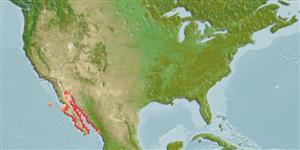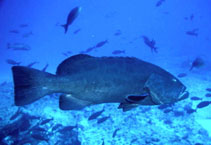Mycteroperca jordani (Jenkins & Evermann, 1889)
Gulf grouper
Masukkan pemerhatian anda di Fish Watcher
| Native range | All suitable habitat | Point map | Year 2050 |

|
| This map was computer-generated and has not yet been reviewed. |
| Mycteroperca jordani AquaMaps Data sources: GBIF OBIS |
muatnaik fotos/gambar dan video
Pictures | Videos | imej GoogleMycteroperca jordani
Picture by Gotshall, D.W.
Pictures | Videos | imej GoogleMycteroperca jordani
Picture by Gotshall, D.W.
klasifikasi / Names Nama-nama umum | Sinonim (persamaan) | Catalog of Fishes(Marga, Jenis) | ITIS | CoL | WoRMS | Cloffa
> Perciformes/Serranoidei (Groupers) > Epinephelidae (Groupers)
Etymology: Mycteroperca: Greek, mykter, -eros = nose + Greek, perke = perch (Ref. 45335).
Eponymy: Dr David Starr Jordan (1851–1931) was a leading American ichthyologist, physician, educator, peace activist and believer in eugenics; moreover, he was founding President of Stanford University. [...] (Ref. 128868), visit book page.
More on authors: Jenkins & Evermann.
Etymology: Mycteroperca: Greek, mykter, -eros = nose + Greek, perke = perch (Ref. 45335).
Eponymy: Dr David Starr Jordan (1851–1931) was a leading American ichthyologist, physician, educator, peace activist and believer in eugenics; moreover, he was founding President of Stanford University. [...] (Ref. 128868), visit book page.
More on authors: Jenkins & Evermann.
Environment: milieu / climate zone / depth range / distribution range Ekologi
laut berasosiasi dengan karang; kisaran kedalaman 5 - 30 m (Ref. 9342). Subtropical; 33°N - 23°N, 119°W - 106°W (Ref. 5222)
Penyebaran Negara-negara | Daerah-daerah FAO | Ecosystems | Kemunculan | Point map | Introduksi | Faunafri
Eastern Central Pacific: southern La Jolla, California, USA to Mazatlan, Mexico.
Size / Weight / umur
Maturity: Lm ? range ? - ? cm
Max length : 198 cm TL jantan/; (Ref. 2850); Berat maksimum terpublikasi: 91.0 kg (Ref. 5222)
Max length : 198 cm TL jantan/; (Ref. 2850); Berat maksimum terpublikasi: 91.0 kg (Ref. 5222)
deskripsi pendek Kunci identifiaksi (pengenalan) | Morfologi | Morfometrik
Duri punggung (Keseluruhan (total)) : 11; duri punggung lunak (Keseluruhan (total)) : 16 - 17; Duri dubur: 3; Sirip dubur lunak: 10 - 11. Distinguished by the following characteristics: uniform dark brown or grey color of adults (can rapidly change into juvenile pattern when disturbed or under stress), large adults with white pectoral fin margin and median fins with narrow white edge; juvenile with greyish brown color, with dark spots along upper half of the body; depth of body 3.1-3.4 times in SL; head length 2.5-2.7 times in SL; rounded preopercle, finely serrate, lacking distinct lobe at the angle; posterior nostrils not notably enlarged, diameter less than twice of anterior nostrils (Ref. 89707).
Found in rocky reefs and kelp beds. Juveniles are unknown in California waters and the few large adults that have been taken there are probably expatriates from a more southerly breeding population. Large adults feed on fishes (Ref. 9342). Reported to prey on juvenile hammerhead sharks. Its large size makes it an object of game fishing (Ref. 9342).
Life cycle and mating behavior Kematangan | Reproduksi, perkembang biakan | Pemijahan | telur-telur | Fecundity | Larva
rujukan utama
Upload your references | Acuan | Koordinator | mitra
Heemstra, P.C. and J.E. Randall, 1993. FAO Species Catalogue. Vol. 16. Groupers of the world (family Serranidae, subfamily Epinephelinae). An annotated and illustrated catalogue of the grouper, rockcod, hind, coral grouper and lyretail species known to date. Rome: FAO. FAO Fish. Synop. 125(16):382 p. (Ref. 5222)
Status IUCN Red List (Ref. 130435: Version 2024-2)
terancam (EN) (A2bd); Date assessed: 20 November 2016
CITES
Not Evaluated
ancaman kepada manusia
Harmless
penggunaan manusia
Perikanan: nilai komersial kecil; Ikan buruan: ya
FAO - Publication: search | FishSource |
informasi lanjut
Population dynamics
Growth parameters
Max. ages / sizes
Length-weight rel.
Length-length rel.
ukuran frekuensi
Mass conversion
pemulihan
Kelimpahan
Growth parameters
Max. ages / sizes
Length-weight rel.
Length-length rel.
ukuran frekuensi
Mass conversion
pemulihan
Kelimpahan
Life cycle
Reproduksi, perkembang biakan
Kematangan
Maturity/Gills rel.
Fecundity
Pemijahan
Spawning aggregations
telur-telur
pekembangan telor
Larva
Dinamika larva
Reproduksi, perkembang biakan
Kematangan
Maturity/Gills rel.
Fecundity
Pemijahan
Spawning aggregations
telur-telur
pekembangan telor
Larva
Dinamika larva
Anatomy
Area insang
Brain
Otolith
Area insang
Brain
Otolith
Physiology
Body composition
Nutrients
Oxygen consumption
Swimming type
Swimming speed
Visual pigments
Fish sound
Diseases & Parasites
Toxicity (LC50s)
Body composition
Nutrients
Oxygen consumption
Swimming type
Swimming speed
Visual pigments
Fish sound
Diseases & Parasites
Toxicity (LC50s)
Genetics
Genetika
Heterozygosity
Diturunkan
Genetika
Heterozygosity
Diturunkan
Human related
Aquaculture systems
profil budidaya air
Strain
Ciguatera cases
Stamps, coins, misc.
Aquaculture systems
profil budidaya air
Strain
Ciguatera cases
Stamps, coins, misc.
Alat, peralatan
Bio-Quiz | E-book | Penuntun lapangan | tanda freqkuenci panjang | peringkat sejarah hidup | peta titik | Classification Tree
| Catch-MSY |
laporan khas
muat turun XML
Sumber internet
AFORO (otoliths) | Aquatic Commons | BHL | Cloffa | BOLDSystems | Websites from users | semak peneliti ikan | CISTI | Catalog of Fishes: Marga, Jenis | DiscoverLife | ECOTOX | FAO - Publication: search | Faunafri | Fishipedia | Fishtrace | GenBank: genom, Nukleotida | GloBI | Google Books | Google Scholar | Google | IGFA World Record | MitoFish | Otolith Atlas of Taiwan Fishes | PubMed | Reef Life Survey | Socotra Atlas | Tree of Life | Wikipedia: pergi, Cari | World Records Freshwater Fishing | Zoological Record
Estimates based on models
Preferred temperature (Ref. 123201): 18.6 - 25.9, mean 23 °C (based on 102 cells).
Phylogenetic diversity index (Ref. 82804): PD50 = 0.5000 [Uniqueness, from 0.5 = low to 2.0 = high].
Bayesian length-weight: a=0.00933 (0.00426 - 0.02047), b=3.05 (2.88 - 3.22), in cm total length, based on LWR estimates for this Genus-body shape (Ref. 93245).
Trophic level (Ref. 69278): 4.5 ±0.80 se; based on food items.
Daya lenting (Ref. 120179): sangat rendah, Waktu penggandaan populasi minimum lebih dari 14 tahun (Preliminary K or Fecundity.).
Fishing Vulnerability (Ref. 59153): Very high vulnerability (90 of 100).
Nutrients (Ref. 124155): Calcium = 8.75 [4.91, 18.12] mg/100g; Iron = 0.397 [0.198, 0.722] mg/100g; Protein = 19.5 [17.7, 21.3] %; Omega3 = 0.163 [0.086, 0.304] g/100g; Selenium = 19.6 [7.2, 42.9] μg/100g; VitaminA = 50.7 [13.8, 195.3] μg/100g; Zinc = 0.454 [0.295, 0.715] mg/100g (wet weight);




